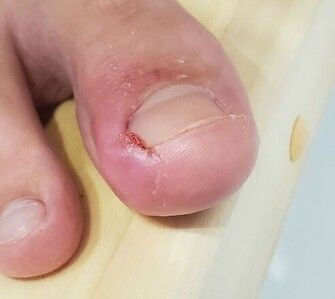What is an ingrown toenail?
When the skin around the toe at the edge of the nail becomes painful, it is likely due to an ingrown toenail. Symptoms may include swelling, redness, inflamed tissue, and sometimes infection.
It's important to note that infections do not occur with all ingrown toenails. Many people experience nail and skin pain due to pressure without the nail penetrating the skin.
Common Causes of Ingrown Toenails
Ingrown toenails are quite a common issue! Roughly 20% of individuals find themselves consulting their GP due to an ingrown toenail, with the majority of these cases involving the big toes, although the smaller toes can be affected as well. While trying home remedies, such as soaking the affected toe in saltwater, might provide temporary relief from symptoms, these methods often fall short of fully addressing ingrown toenails that have been troubling you for more than two weeks.Several factors contribute to the development of ingrown toenails. Genetics play a significant role, making some people more prone to this condition. Wearing footwear that is too narrow or short can also lead to problems, as can participating in sports that require tight-fitting shoes. Teenagers, in particular, may experience ingrown toenails more frequently due to sweaty feet. Additionally, improper nail care, such as poor trimming techniques or the habit of tearing or pulling at the nail, can also cause ingrown toenails. Understanding these causes can help in preventing the issue from arising in the first place.


The three stages of ingrown toenails:
Stage 1:
Symptoms present for less than two weeks
Mild redness and/or swelling
Stage 2:
Increased pain
Infection may be present, possibly with pus
Small increase in tissue growth (granuloma)
Stage 3:
Symptoms present for more than two weeks
Pus-associated infection
Increased tissue surrounding the nail
Granulation tissue covering part of the nail plate
Ingrown Toenail Treatment:
Treating ingrown toenails can vary in complexity based on the stage:
Step 1: Non-surgical treatments include general nail care, salt baths, nail taping, or bracing.
Step 2: Conservative options may be attempted, but surgery is indicated if these efforts fail.
Step 3: Surgical approaches are often the most effective for severe cases.


